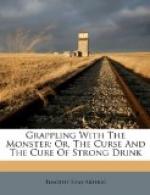It remains now to show how far prohibitory laws, when enforced, have secured the end for which they were created. On this point, the evidence is clear and satisfactory. In Vermont, a prohibitory law has existed for over twenty-three years. In some parts of the State it is rigidly enforced; in others with less severity. Judge Peck, of the Supreme Court says: “The law has had an effect upon our customs, and has done away with that of treating and promiscuous drinking. * * * In attending court for ten years, I do not remember to have seen a drunken man." In St. Johnsbury, where there is a population of five thousand, the law has been strictly enforced; and the testimony in regard to the town is this: “There is no bar, no dram-shop, no poor, and no policeman walks the streets. It is the workingman’s paradise.”
Connecticut enacted a prohibitory law in 1854. In 1855, Governor Dutton said, in his annual message to the General Assembly: “There is scarcely an open grog-shop in the State, the jails are fast becoming tenantless, and a delightful air of security is everywhere enjoyed.”
In Meriden, the chaplain of the reform school testified that “crime had diminished seventy-five per cent.” In New London, the jail was tenantless. In Norwich, the jails and almshouses were reported “as almost empty.” But in 1873, the liquor influence was strong enough in the legislature to substitute license for prohibition. The consequence was an immediate increase of drunkenness and crime. Two years afterwards, the Secretary of State declared that “there was a greater increase of crime in one year under license than in seven years under prohibition.”
Vineland, New Jersey, has a population of ten thousand. Absolute prohibition is the law of that community. One constable, who is also overseer of the poor, is sufficient to maintain public order. In 1875, his annual report says: “We have practically no debt. * * * The police expenses of Vineland amount to seventy-five dollars a year, the sum paid to me, and our poor expenses are a mere trifle.”
In Potter County, Pennsylvania, there has been a prohibitory law for many years. Hon. John S. Mann says: “Its effect, as regards crime, is marked and conspicuous. Our jail is without inmates, except the sheriff, for more than half the time.”
Other instances of local prohibition in this country could be given, but these are sufficient.
Bessbrook, a town in Ireland of four thousand inhabitants, has no liquor-shop, and whisky and strong drink are strictly prohibited. There is no poor-house, pawn-shop or police-station. The town is entirely free from strife, discord or disturbance.
In the county of Tyrone, Ireland, no drinking house is allowed. In 1870, Right Hon. Claude Hamilton said: “At present there is not a single policeman in that district. The poor-rates are half what they were before, and the magistrates testify to the great absence of crime.”




